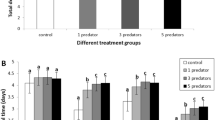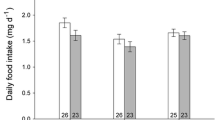Abstract
Despite the potential impact on prey fitness and predator–prey interactions, most studies of predation risk ignore physiological responses and their dependence upon food level and sex. Therefore, we reared male and female larvae of the damselfly Lestes viridis under predator stress (dragonfly larvae) at high and low food levels, and subsequently scored for important variables of insect immune defence (i.e. phenoloxidase) and antioxidant defence [i.e. superoxide dismutase, and catalase (CAT)]. Under predation risk, larvae did not decrease growth rate or immune defence, and only slightly reduced food intake in the high food treatment, probably because of time stress, i.e. little time available to complete the larval development. However, larvae facing predator stress did show an upregulation of antioxidant enzymes. This upregulation was dependent upon food level for CAT and both food level and sex for SOD, consistent with energetic constraints and sex differences in the link between longevity and adult fitness. Our results illustrate that predator stress can influence life history, behavioural and physiological responses differentially and in a context-dependent way. This implies that non-consumptive physiological effects of predators on their prey show independent yet similar complexities in behavioural and life history response variables. In general, our results advocate that mechanistic studies on predator–prey interactions may benefit from including physiological variables.

Similar content being viewed by others
References
Aebi H (1984) Catalase in vitro. Methods Enzymol 105:121–126
Ahmad S (1992) Biochemical defense of prooxidant plant allelochemicals by herbivorous insects. Biochem Syst Ecol 20:269–296
Alonso-Alvarez C, Bertrand S, Devevey G, Prost J, Faivre B, Sorci G (2004) Increased susceptibility to oxidative stress as a proximate cost of reproduction. Ecol Lett 7:363–368
Alonso-Alvarez C et al (2006) An experimental manipulation of life history trajectories and resistance to oxidative stress. Evolution 60:1913–1924
Altwegg R, Reyer HU (2003) Patterns of natural selection on size at metamorphosis in water frogs. Evolution 57:872–882
Anholt BR, Werner EE (1995) Interaction between food availability and predation mortality mediated by adaptive behavior. Ecology 76:2230–2234
Anholt BR, Werner E, Skelly DK (2000) Effect of food and predators on the activity of four larval ranid frogs. Ecology 81:3509–3521
Banks MJ, Thompson DJ (1985) Lifetime mating success in the damselfly Coenagrion puella. Anim Behav 33:1175–1183
Banks MJ, Thompson DJ (1987) Lifetime reproductive success of females of the damselfly Coenagrion puella. J Anim Ecol 56:815–832
Bateman AJ (1948) Intra-sexual selection in Drosophila. Heredity 2:349–368
Beckerman AP, Wieski K, Baird DJ (2007) Behavioural versus physiological mediation of life history under predation risk. Oecologia 152:335–343
Costa MJ, Monteiro DA, Oliveira-Neto AL, Rantin FT, Kalinin AL (2008) Oxidative stress biomarkers and heart function in bullfrog tadpoles exposed to Roundup Original. Ecotoxicology 17:153–163
De Block M, Stoks R (2004) Cannibalism-mediated life history plasticity to combined time and food stress. Oikos 106:587–597
De Block M, Stoks R (2005) Fitness effects from egg to reproduction: bridging the life history transition. Ecology 86:185–197
De Block M, Stoks R (2008a) Compensatory growth and oxidative stress in a damselfly. Proc R Soc B Biol Sci 275:781–785
De Block M, Stoks R (2008b) Short-term larval food stress and associated compensatory growth reduce adult immune function in a damselfly. Ecol Entomol 33:796–801
Felton GW, Summers CB (1995) Antioxidant systems in insects. Arch Insect Biochem Physiol 29:187–197
Fincke O (1988) Sources of variation in lifetime reproductive success in a nonterritorial damselfly (Odonata: Coenagrionidae). In: Clutton-Brock TH (ed) Reproductive success: studies of individual variation in contrasting breeding systems. University of Chicago Press, Chicago, pp 24–43
Johansson F, Stoks R, Rowe L, De Block M (2001) Life history plasticity in a damselfly: effects of combined time and biotic constraints. Ecology 82:1857–1869
Joop G, Rolff J (2004) Plasticity of immune function and condition under the risk of predation and parasitism. Evol Ecol Res 6:1051–1062
Korsloot A, van Gestel CAM, van Straalen NM (2004) Environmental stress and cellular response in arthropods. CRC, Boca Raton
Krishnan N, Kodrìk D (2006) Antioxidant enzymes in Spodoptera littoralis (Boisduval): are they enhanced to protect gut tissues during oxidative stress? J Insect Physiol 52:11–20
Lima SL, Bednekoff PA (1999) Temporal variation in danger drives antipredator behavior: the predation risk allocation hypothesis. Am Nat 153:649–659
Loft S, Astrup A, Buemann B, Poulsen HE (1994) Oxidative DNA-damage correlates with oxygen-consumption in humans. FASEB J 8:534–537
Martin I, Grotewiel MS (2006) Oxidative damage and age-related functional declines. Mech Ageing Dev 127:411–423
McPeek MA, Grace M, Richardson JML (2001) Physiological and behavioral responses to predators shape the growth/predation risk trade-off in damselflies. Ecology 82:1535–1545
Mikolajewski DJ, Brodin T, Johansson F, Joop G (2005) Phenotypic plasticity in gender specific life history: effects of food availability and predation. Oikos 110:91–100
Mikolajewski DJ, Joop G, Wohlfahrt B (2007) Coping with predators and food limitation: testing life history theory for sex-specific larval development. Oikos 116:642–649
Mikolajewski DJ, Stoks R, Rolff J, Joop G (2008) Predators and cannibals modulate sex-specific plasticity in life history and immune traits. Funct Ecol 22:114–120
Mittapalli O, Neal JJ, Shukle RH (2007) Antioxidant defense response in a galling insect. Proc Natl Acad Sci USA 104:1889–1894
Nunn CL, Lindenfors P, Rhiannon Pursall E, Rolff J (2009) On sexual dimorphism in immune function. Philos Trans R Soc B 364:61–69
Preisser EL, Bolnick DI, Benard MF (2005) Scared to death? The effects of intimidation and consumption in predator–prey interactions. Ecology 86:501–509
Rantala MJ, Vainikka A, Kortet R (2003) The role of juvenile hormone in immune function and pheromone production trade-offs: a test of the immunocompetence handicap principle. Proc R Soc Lond B Biol Sci 270:2257–2261
Relyea RA (2004) Integrating phenotypic plasticity when death is on the line. In: Pigliucci MPK (ed) Phenotypic integration. Studying the ecology and evolution of complex phenotypes. Oxford University Press, Oxford, pp 176–190
Rigby MC, Jokela J (2000) Predator avoidance and immune defence: costs and trade-offs in snails. Proc R Soc Lond B Biol Sci 267:171–176
Rolff J (2001) Effects of age and gender on immune function of dragonflies (Odonata, Lestidae) from a wild population. Can J Zool-Rev Can Zool 79:2176–2180
Rolff J (2002) Bateman’s principle and immunity. Proc R Soc Lond B Biol Sci 269:867–872
Rolff J, Siva-Jothy MT (2004) Selection on insect immunity in the wild. Proc R Soc Lond B Biol Sci 271:2157–2160
Rolff J, Van de Meutter F, Stoks R (2004) Time constraints decouple age and size at maturity and physiological traits. Am Nat 164:559–565
Sapolsky RM (1992) Neuroendocrinology of the stress response. In: Becker JB, Breedlove SM, Crews D (eds) Behavioral endocrinology. Massachusetts Institute of Technology, Cambridge, MA, pp 287–324
Semba RD et al (2007) Oxidative stress and severe walking disability among older women. Am J Med 120:1084–1089
Sibly RM, Calow P (1989) A life-cycle theory of responses to stress. Biol J Linn Soc 37:101–116
Sih A (1984) Optimal behavior and density-dependent predation. Am Nat 123:314–326
Sih A, Bell AM, Kerby JL (2004) Two stressors are far deadlier than one. Trends Ecol Evol 19:274–276
Siva-Jothy MT, Moret Y, Rolff J (2005) Insect immunity: an evolutionary ecology perspective. Adv Insect Phys 32:1–48
Slos S, Stoks R (2008) Predation risk induces stress proteins and reduces antioxidant defense. Funct Ecol 22:637–642
Steiner UK, Pfeiffer T (2007) Optimizing time and resource allocation trade-offs for investment into morphological and behavioral defense. Am Nat 169:118–129
Stoehr AM, Kokko H (2006) Sexual dimorphism in immunocompetence: what does life history theory predict? Behav Ecol 17:751–756
Stoks R (2001) Food stress and predator-induced stress shape developmental performance in a damselfly. Oecologia 127:222–229
Stoks R, De Block M (2000) The influence of predator species and prey age on the immediate survival value of antipredator behaviours in a damselfly. Arch Hydrobiol 147:417–430
Stoks R, McPeek MA (2003a) Predators and life histories shape Lestes damselfly assemblages along a freshwater habitat gradient. Ecology 84:1576–1587
Stoks R, McPeek MA (2003b) Antipredator behavior and physiology determine Lestes species turnover along the pond-permanence gradient. Ecology 84:3327–3338
Stoks R, De Block M, Van de Meutter F, Johansson F (2005a) Predation cost of rapid growth: behavioural coupling and physiological decoupling. J Anim Ecol 74:708–715
Stoks R, De Block M, McPeek MA (2005b) Alternative growth and energy storage responses to mortality threats in damselflies. Ecol Lett 8:1307–1316
Stoks R, De Block M, Slos S, Van Doorslaer W, Rolff J (2006a) Time constraints mediate predator-induced plasticity in immune function, condition, and life history. Ecology 87:809–815
Stoks R, De Block M, McPeek MA (2006b) Physiological costs of compensatory growth in a damselfly. Ecology 87:1566–1574
Werner EE, Anholt BR (1993) Ecological consequences of the trade-off between growth and mortality-rates mediated by foraging activity. Am Nat 142:242–272
Werner EE, Peacor SD (2003) A review of trait-mediated indirect interactions in ecological communities. Ecology 84:1083–1100
Werner EE, Peacor SD (2006) Lethal and nonlethal predator effects on an herbivore guild mediated by system productivity. Ecology 87:347–361
Woodley CM, Peterson MS (2003) Measuring responses to simulated predation threat using behavioral and physiological metrics: the role of aquatic vegetation. Oecologia 136:155–160
Zhang JX et al (2003) Effects of weasel odor on behavior and physiology of two hamster species. Physiol Behav 79:549–552
Acknowledgments
We thank Ine Swillen for improving the first draft of this paper and two anonymous referees for valuable comments on an earlier version of the manuscript. S. S. is a PhD IWT scholar. This study was funded by research grants from FWO and the Katholieke Universiteit Leuven Research Fund. The experiments were carried out under a permit of the Flemish Government.
Author information
Authors and Affiliations
Corresponding author
Additional information
Communicated by Anssi Laurila.
Rights and permissions
About this article
Cite this article
Slos, S., De Meester, L. & Stoks, R. Food level and sex shape predator-induced physiological stress: immune defence and antioxidant defence. Oecologia 161, 461–467 (2009). https://doi.org/10.1007/s00442-009-1401-2
Received:
Accepted:
Published:
Issue Date:
DOI: https://doi.org/10.1007/s00442-009-1401-2




